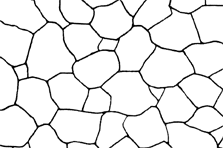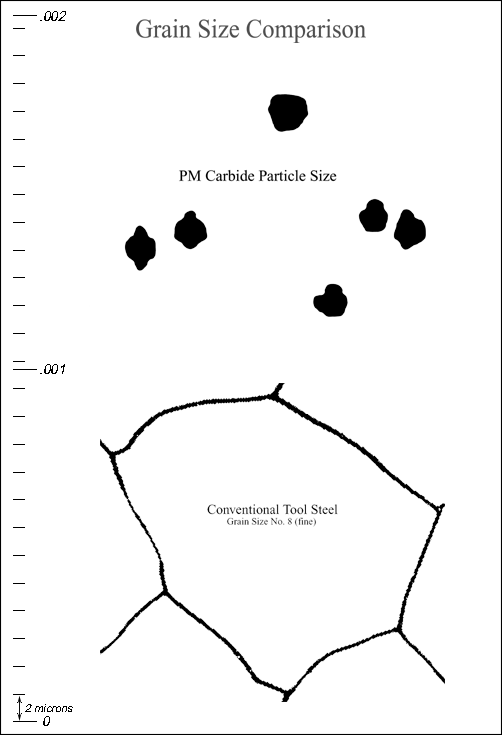The edge properties of a blade are affected by the microstructure of the steel. Microstructure refers to the size and pattern of microscopic variations in the composition and structure of the steel. It differs according to the elements that make up the alloy and especially the heat treatment the blade has received. As steel is heated and cooled, it takes on forms known as phases with names like austenite, martensite, and pearlite. These phases have very different qualities, and successful heat treatment leaves a blade with the steel in the proper phase for its intended use.
The phase of steel most important for good edge qualities is martensite, which has a crystalline structure that appears needle-like under magnification. Martensite is harder than other phases of steel, and its structure makes it brittle. At high temperatures steel enters a phase known as austenite, which is able to dissolve more carbon than other phases. When the austenite is cooled quickly by quenching, the carbon remains trapped in the crystal structure, resulting in martensite. This transformation is often not complete, leaving some of the steel in the form of retained austenite. This retained austenite is unstable, and can be converted to martensite by stressing the steel by bending (one type of work hardening), or by further thermal stress such as cryogenic treatment. The martensite that is formed by these processes is brittle just like the martensite in an untempered blade, and will benefit from tempering.
In addition to taking on the martensite phase, carbon steel and other alloys form grain that resembles grains of sand packed together. Fine grain means that these grains are small in size. Steel with fine grain will have better strength and toughness than coarse grained steel, while coarse grained steel will have better machinability. This image shows what grain looks like:

To determine the grain size of a metal specimen it is polished and then etched with acid so that the grain boundaries can be seen under a microscope. Grain size is described by the numbers shown here:
ADD TABLE HERE
Although this chart stops at grain size 8, finer grain sizes are sometimes found in woodworking tools. A review of chisels published in Fine Woodworking (vol. 55, March 1985) reports the results of tests on ten chisels which had steel that ranged in grain size from 6 to 11. In that test the best edge retention was found in Japanese chisels that had grain sizes of 8 to 10 with a hardness of Rc 60.5 to 63.5. The chisels with grain size 11 were German and American. These were less hard (Rc 59.5 to 62) and scored slightly below the Japanese chisels in edge retention.
Alloys that include certain elements such as tungsten and vanadium can form carbides that are suspended in the steel. Carbide is harder than steel and gives the steel better abrasion resistance. Small carbide particles evenly distributed throughout the steel matrix give the alloy good abrasion resistance. Large carbide particles unevenly distributed can make the alloy difficult to grind without imparting good edge qualities.
Different types of carbide vary in hardness and abrasion resistance.
To compare the size and distribution of grain and carbide particles, I’ve put together images at the same scale, shown below.

At the top are black dots that show the size and distribution of carbide particles produced by a particle metallurgy process. These particles are smaller than those produced by conventional methods. At the bottom is one full grain of the type typical of carbon steel. The size shown (number 8) is the finest illustrated in my reference book. Along the left is a scale showing both microns and thousandths of an inch.
Here is an image of the carbides present in M4 particle metallurgy steel, also at the same scale:

The largest of these carbides are about the size of the ones in the illustration above, and this image seems to suggest that there are also smaller particles of carbide present. If this is true, it would help explain the good abrasion resistance of particle metallurgy alloys.
The purpose of these images is to give an idea of the relative sizes of these features of the microstructure compared to the thickness of a shaving from a plane. A fine shaving from a smoothing plane is typically between .001 and .002 inches.
According to a 1956 study by the UK Forest Products Research Lab (Special Report No. 11, The Blunting of Wood Cutting Edges), the edge of a sharp blade is between 1 and 2 microns wide. This is somewhat smaller than the diameter of the largest carbide particles produced by the particle metallurgy process. If the carbide particles themselves are not worn away by the honing abrasive they will remain rounded until they become dislodged from the surrounding steel matrix. This suggests that putting a very sharp edge on a blade that contains carbide particles requires a honing medium hard enough to abrade carbide.